Learn top strategies for video marketing on social media and boost your brand's reach with proven techniques. Perfect your video content today!
In This Article
Subscribe to our newsletter
When we talk about video marketing on social media, we're talking about much more than just posting a video. It’s the art of using video to connect with people, build up your brand, and ultimately drive action on platforms like Instagram, TikTok, and YouTube.
Honestly, it’s probably the most powerful tool you have in your marketing arsenal right now. Nothing else combines visuals, sound, and storytelling to grab attention in a crowded feed quite like video.
Why Video Dominates Social Media Marketing

Let's face it: standing out on social media is tough. Feeds are endless, and people's attention spans are getting shorter by the second. In this environment, video isn't just another option; it's the undisputed champ at capturing and holding someone's focus.
Think of it this way. A text post is like a flat photograph—it captures a single moment. A video, on the other hand, is like an interactive 3D model. It can demonstrate, explain, and connect with viewers on a much deeper, more emotional level.
This is what makes video such a game-changer for storytelling. It lets you show your brand's personality and convey value in a way static images and text just can't touch. You’re creating a multi-sensory experience that’s way more memorable and persuasive.
Humanizing Your Brand Through Motion
One of the biggest wins with video marketing on social media is its incredible ability to put a human face on your brand. When you show the people behind the scenes, share a raw, unedited moment, or feature a real customer story, you build a layer of authenticity that's priceless.
This kind of transparency is what builds real trust and loyalty. It turns passive followers into a genuine community that actually cares about what you're doing.
A few key benefits really stand out here:
- Sky-High Engagement: Videos just naturally get more likes, comments, and shares. This tells the platform algorithms that your content is worth showing to more people.
- Better Message Retention: People remember what they see in a video far better than what they read in a block of text. Your message actually sticks.
- Real Conversion Impact: From quick product demos to helpful tutorials, video is amazing at guiding people from casual interest to making a purchase. You can learn more about the power of video and what it can do for your business in our deep-dive article.
The Numbers Don't Lie
This huge shift to video isn't just a hunch; the data is overwhelming. The growth has been absolutely explosive, with some projections showing video will make up 82% of all internet traffic by 2025. That’s massive.
It's also why 54% of marketers are now using AI tools to create videos more efficiently, a trend highlighted in recent video marketing statistics from Teleprompter.com.
Let’s put it plainly: if your brand isn’t creating video for social media, you’re on your way to becoming invisible. The platforms prioritize it, your audience prefers it, and the results speak for themselves.
At this point, video isn't just a "nice-to-have." It’s a core part of any strategy for businesses that want to make a real impact, grow their audience, and stay relevant.
Choosing the Right Platform for Your Videos
Trying to post the same exact video everywhere is a bit like wearing a tuxedo to a beach party—it just doesn't fit the vibe. The secret to effective video marketing on social media is understanding that each platform has its own unique culture and audience. You have to match your message to the right mindset.
Think about it. Someone scrolling through LinkedIn is in a professional headspace, looking for industry knowledge or career tips. Flip over to TikTok, and that same person is now seeking pure entertainment, trends, and quick, creative escapes. A detailed corporate explainer that kills it on LinkedIn would get swiped away in a heartbeat on TikTok.
Getting this distinction right is everything. It's how you make sure your time, budget, and creative energy actually connect with people where it matters most.
Aligning Your Content with Platform Culture
Every social media network has its own unwritten rules. To win, you've got to speak the local language. One of the biggest mistakes brands make is forcing a video into a format or style that feels completely alien to the platform's regulars.
TikTok: This is the land of authenticity, trends, and pure, unadulterated fun. Videos here should feel spontaneous, not slick. Jumping on a trending sound or a popular challenge is the name of the game. Polished corporate ads stick out like a sore thumb; people want to see the real, human side of your brand.
Instagram: It all started with photos, but Instagram is now a video machine, dominated by Reels and Stories. The content here is highly visual, often polished, and aspirational. It's the perfect spot for beautiful product showcases, behind-the-scenes content, and influencer collaborations that feel inspiring.
LinkedIn: Welcome to the professional world. Videos on LinkedIn need to be genuinely informative and add value to someone's career. Think expert interviews, deep dives into industry trends, or tutorials that teach a valuable skill. The goal isn't just to get views—it's to build authority and be seen as a thought leader.
This infographic really highlights the differences in how users behave across these platforms.
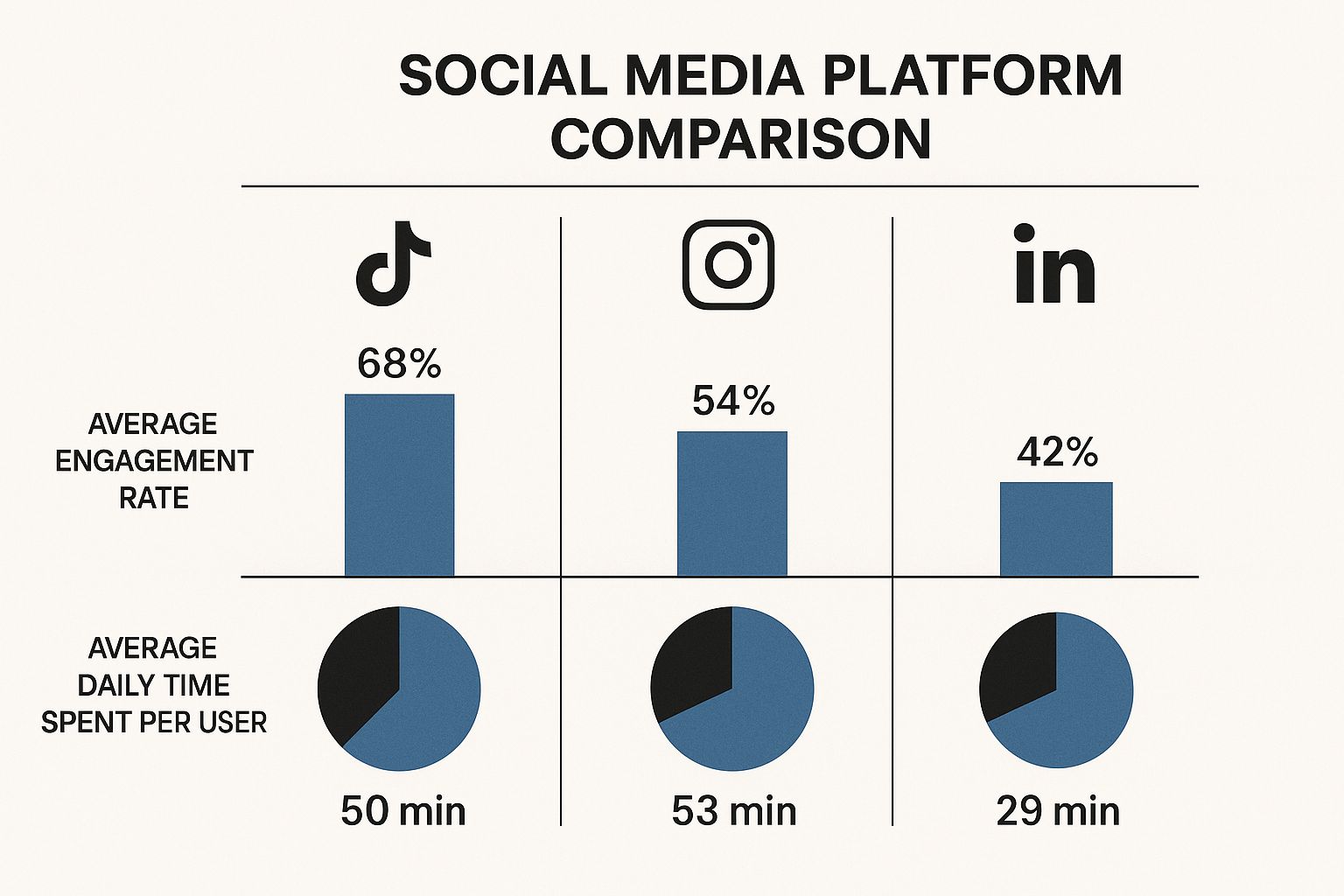
As you can see, people might spend more time scrolling on Instagram and TikTok, but the LinkedIn audience is highly focused. Even if they spend less time on the platform, their attention is dialed in, making it a goldmine for targeted B2B content.
To help you map this out, here’s a quick comparison of how to approach video strategy across the major players.
Social Media Platform Video Strategy Comparison
| Platform | Primary Audience | Best Video Formats | Strategic Focus |
|---|---|---|---|
| TikTok | Gen Z & Millennials | Short-form vertical (Reels-style), trends, user-generated content (UGC) | Brand awareness, community building, viral entertainment |
| Millennials & Gen Z | Polished vertical Reels, ephemeral Stories, influencer content | Aesthetic showcases, lifestyle marketing, behind-the-scenes | |
| Gen X & Millennials | Short feed videos (square), Live streams, long-form (Watch) | Community engagement, driving traffic, broad-reach ads | |
| YouTube | All demographics | Long-form horizontal (tutorials, reviews), Shorts (vertical) | In-depth education, SEO, building long-term authority |
| Professionals, B2B | Short informational clips, expert interviews, webinars, case studies | Thought leadership, lead generation, professional networking |
Choosing the right platform is the first step, but aligning your video format with what the audience on that platform expects is just as crucial for success.
Matching Video Format to Audience Intent
Beyond the platform's general vibe, you have to think about the specific type of video that works best. And no, just resizing your video from horizontal to vertical isn't enough. The pacing, editing style, and even the story structure need to adapt.
Short, vertical clips are the undisputed kings of TikTok and Instagram Reels. For these, you have to hook the viewer in the first two seconds or you're toast. But over on YouTube, it's a completely different game. It’s the home of long-form, horizontal video, where people are ready to settle in for a deep-dive tutorial or a detailed product review.
Choosing the right platform isn't just about where your audience hangs out. It's about meeting them where they are mentally and delivering content in a format they already love. That's how you turn passive views into real engagement.
Facebook is a bit of a hybrid, supporting everything from quick, square videos in the feed to longer content on Facebook Watch and casual, ephemeral Stories. This flexibility is great, but it means you need a specific goal for every video. Are you trying to grab attention in the feed? Use a short, punchy clip. Want to build a deeper connection? Go live with a Q&A session.
The numbers don't lie. As of Q3 2024, a staggering 92.3% of internet users globally watch online videos. For B2B brands, 70% of marketers now use LinkedIn for their campaigns, while Instagram and Facebook are the top dogs for consumer ad engagement.
Finally, don't forget the technical details. Each platform has its own rules for aspect ratios, video length, and file sizes. To make sure your hard work looks perfect everywhere, check out our complete social media video sizes guide.
Mastering High-Impact Social Video Formats
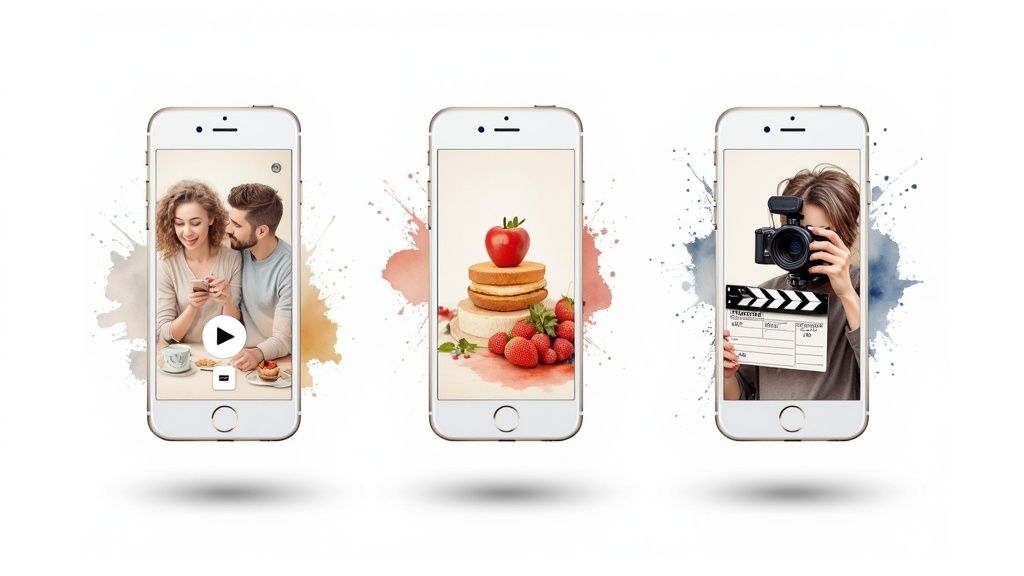
When you're building out your social media video strategy, trying to make one type of video fit every goal is a recipe for failure. The smartest brands don't just "do video"—they have a whole toolkit of video formats, and they know exactly when to use each one.
Think about it like this: you wouldn't use a hammer to saw a piece of wood, right? In the same way, a long, detailed explainer video won't work when you need a quick, punchy Reel to stop the scroll. Knowing the difference is what separates a content calendar that flops from one that consistently crushes its goals.
The Power of Short-Form Vertical Video
Let's start with the undisputed champs of discovery: short-form vertical videos like Instagram Reels and TikToks. These quick, under-60-second clips are designed to be consumed on the fly, making them perfect for grabbing attention in today's fast-paced feeds.
They're essentially your brand's elevator pitch. This is where you can:
- Build Brand Awareness: Introduce your brand in a fun, digestible way.
- Showcase Personality: Use trends, humor, and a bit of authenticity to show people who you are.
- Drive Initial Interest: Drop a quick tip or a product sneak peek that leaves them wanting more.
And the data doesn't lie. A massive 78% of people now say they prefer to learn about a new product by watching a short video. That alone shows how vital these clips are for getting your brand in front of new eyes.
It’s also a big reason why 90% of marketers report that video marketing delivers a solid return on investment. If you want to dig into the numbers yourself, check out this great report on video marketing statistics from Vidico.
Fostering Community with Live Video
If short-form video is the handshake, then live video is the deep, meaningful conversation that follows. Going live on platforms like Instagram Live or YouTube Live is your chance to connect with your audience in a completely unfiltered, real-time way.
There's an energy to live video that you just can't replicate. It creates a feeling of urgency and exclusivity, stripping away the polished production to build some serious trust.
Live video is your direct line to your community. It’s where you can answer questions, gather instant feedback, and humanize your brand in a way that pre-recorded content simply cannot.
Fire up a live stream for things like:
- Q&A Sessions: Let your audience ask you anything.
- Product Demos: Walk people through how your product works, live.
- Exclusive Events: Give your followers a front-row seat to a launch or a special announcement.
This kind of direct engagement is pure gold for building a loyal community that feels truly connected to your brand.
Delivering Value with In-Depth Explainers
While short clips grab attention, longer explainer videos are where you build authority and deliver real, tangible value. You'll typically find these on platforms like YouTube or embedded on a website, created for an audience that’s actively looking for answers.
This is your opportunity to become the go-to resource in your niche. Think of these videos as mini-masterclasses designed to solve a very specific problem for your ideal customer.
Some of the most effective in-depth formats include:
- Tutorials and How-To Guides: Show people how to do something valuable, step-by-step.
- Case Studies and Testimonials: Tell detailed stories of how you've helped others get real results.
- Webinar Replays: Package your best educational content to position yourself as an expert.
By sharing your expertise so generously, you attract a much more qualified audience—people who are already looking for the solution you provide.
Building Authenticity with Behind-the-Scenes Content
Finally, don't ever underestimate the power of pulling back the curtain. Behind-the-scenes (BTS) content is a fantastic way to build authenticity and make your audience feel like they're part of your inner circle.
This format is perfect for more casual, ephemeral content like Instagram Stories, but it can also work as short clips in your main feed. It’s all about showing the real people and the real processes that make your business run.
Whether you're sharing a quick tour of your workspace or showing how a product gets made, BTS content makes your brand feel less like a faceless company and more like a team of relatable, trustworthy people.
Creating Great Videos Without a Huge Budget
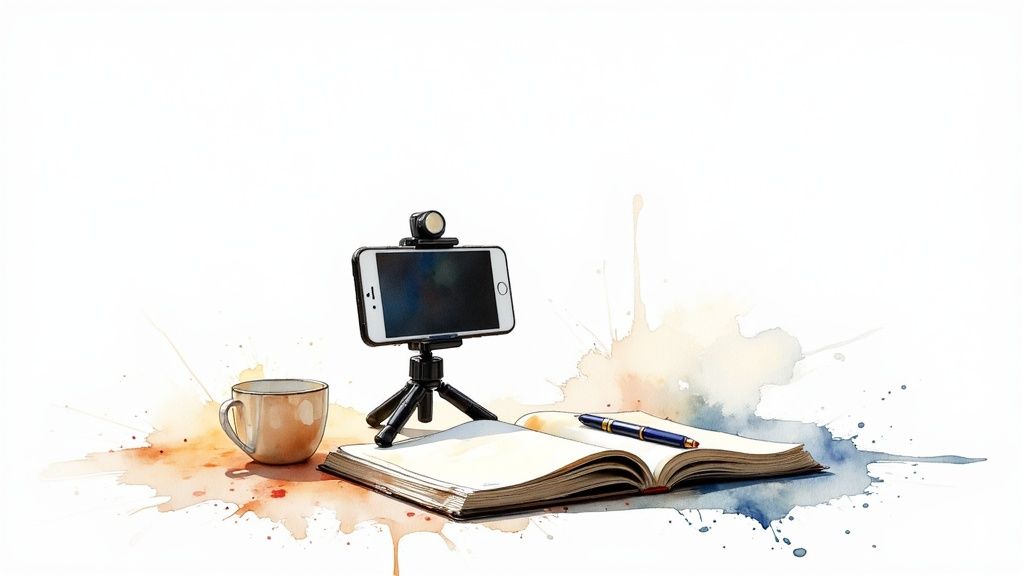
Let's bust one of the biggest myths in video marketing on social media: the idea that you need a Hollywood-sized budget to create anything worthwhile. This single misconception holds so many businesses back, stopping them from connecting with their audience in a truly powerful way.
Here’s the reality. In the fast-paced, scroll-heavy world of social media, authenticity and value almost always win against slick, expensive productions. The powerful camera you already have in your pocket is more than enough to get the job done.
On social media, raw and real often feels more trustworthy than polished and perfect. Audiences crave genuine connection, and you don't need a huge budget to deliver that.
The key isn't to spend more; it's to work smarter. By focusing on a few basic techniques, you can create engaging videos that look and sound fantastic without ever breaking the bank.
Master the Basics of Smartphone Videography
Think of your smartphone as a complete, budget-friendly production studio. The cameras in modern phones are incredibly sophisticated, but how you use them makes all the difference. A few simple tweaks can instantly elevate your footage from amateur to pro.
Two things are absolutely non-negotiable: good lighting and clear audio. These two elements have a bigger impact on how people perceive your video's quality than the camera itself.
Lighting is Everything: Natural light is your best friend, and it's free. Try filming facing a window to get soft, flattering light on your subject. Whatever you do, avoid having a bright light source (like that same window) behind your subject, or you'll end up with a dark silhouette.
Audio Can't Be an Afterthought: Nothing makes viewers scroll away faster than bad audio. An inexpensive lavalier microphone that clips onto a shirt can dramatically improve sound quality, ensuring your message comes through crisp and clear.
Stability is Key: Nobody likes watching shaky footage. It just looks unprofessional. A small, affordable tripod is a great investment, but even propping your phone against a stack of books will give you a steady, watchable shot.
Simple Scripting and Easy Editing
A great video always starts with a plan. This doesn't mean you need a formal, word-for-word script. A simple outline or a few bullet points is often enough to keep you on track and make sure your message is clear. Just ask yourself: what’s the one thing I want my audience to take away from this? Build your video around that.
Once you’ve got your shots, the editing process is where the magic really happens. And the good news? You no longer need complicated, expensive software. There are dozens of powerful and surprisingly easy-to-use editing apps right on your phone.
To help sort through the options, check out this great guide on the best video editing software for beginners. Many of these apps let you trim clips, add text, and drop in music with just a few taps.
And if you’re looking to get even more strategic, we’ve put together some proven strategies on how to reduce production costs while still creating high-quality work. Remember, smart planning and the right tools are your secret weapons for making affordable, high-impact video content.
Building a Winning Video Distribution Strategy
Let’s be honest. Creating a brilliant video is only half the battle. If no one ever sees it, all that hard work might as well have never happened. A truly winning video strategy hinges on a powerful distribution plan to get your content in front of the right eyeballs, at exactly the right time.
Think of your video as a meticulously crafted ship. Without a map and a strong wind (that’s your distribution strategy), it’s just going to sit in the harbor, looking pretty but going nowhere. Distribution is what actually pushes your video across crowded social feeds to connect with the people you want to reach.
The trick is to use a smart mix of organic tactics to build natural momentum and paid advertising to give it a targeted, rocket-fueled push. This combination ensures every single video delivers maximum visibility and actually moves the needle on your marketing goals.
Amplifying Your Organic Reach
Organic distribution is all about making your video as easy to find as possible without opening your wallet for ads. This means you have to play nice with each platform's algorithm, not fight against it.
A huge piece of this puzzle is treating your titles and descriptions like prime real estate. This is where platform-specific SEO comes into play. Just like you would for a blog post, you need to bake in the relevant keywords your audience is already typing into the search bar.
- Compelling Titles: Your titles need to grab attention by promising a benefit or sparking a little curiosity. Instead of a snooze-fest like "New Product Video," try something like, "The 60-Second Secret to Solving [Your Customer's Problem]." See the difference?
- Detailed Descriptions: Don't skimp here. Use the description to give context, quickly summarize the video's value, and include a clear call-to-action (CTA). Every word is another signal to the platform's search algorithm, boosting your chances of being discovered.
- Strategic Hashtags: A solid hashtag strategy is a blend of broad, trending tags and the more niche, community-specific ones. This approach helps your video show up in both massive conversations and highly targeted searches, which can dramatically expand its reach.
Leveraging Platform Features and Paid Advertising
Beyond the basics, social platforms are packed with unique features designed to help you collaborate and get more reach. Take Instagram's Collabs feature, for example. It lets you co-author a post with another account, instantly dropping your video in front of both of your audiences. It's an incredibly simple and effective way to tap into new, relevant communities.
But let's face it, organic reach isn't what it used to be. This is where paid video advertising becomes your best friend. Paid ads are the most direct way to guarantee your video lands in front of your ideal customer.
Think of organic reach as building a loyal local following, one street at a time. Paid advertising is like buying a billboard on the busiest highway in town—it offers immediate, targeted visibility at a massive scale.
With paid campaigns, you can get incredibly specific about who sees your video:
- Demographics: Zero in on users by age, gender, location, and language.
- Interests: Reach people based on the pages they follow, the content they interact with, and their stated interests.
- Behaviors: Target users based on their online activities, like recent purchases or the type of device they're using.
This level of precision means your ad spend isn't just a shot in the dark. You’re putting your message directly in front of the people most likely to care and convert. A fitness brand, for instance, could run a campaign targeting users who’ve recently shown interest in "healthy recipes" or follow popular fitness influencers. It’s that direct.
By weaving together robust organic optimization with sharply targeted paid promotion, you create a complete video distribution machine. This two-pronged approach ensures your content not only keeps your existing followers engaged but also consistently pulls in new, qualified viewers, turning your video marketing efforts into a predictable engine for growth.
Measuring Video Performance and Proving ROI
Making a great video is just the start. The real gut-check for your video marketing on social media strategy is whether it's actually moving the needle for your business. Let's be honest, vanity metrics like views and likes feel good, but they don't pay the bills. They can't tell you if your efforts are truly working.
To get the real story, you have to dig past those surface-level numbers and focus on data that ties directly to your business goals. This is all about tracking the metrics that show genuine engagement, audience interest, and most importantly, conversions. Only then can you actually prove the return on your investment.
Key Metrics That Actually Matter
It’s time to trade the ego boost of vanity metrics for the cold, hard facts of what your audience is really doing. These numbers tell a much richer story about what's landing and what's falling flat, empowering you to make smarter moves.
Here are the core metrics you should have your eyes on:
Engagement Rate: This is your best signal for whether your video truly connected with people. It lumps together likes, comments, shares, and saves, showing that your content was compelling enough to make someone do something. A high engagement rate is also a major signal to platform algorithms that your content is worth showing to more people.
Audience Retention: This metric is like a roadmap of your viewer's attention span. It shows you the exact moment they lose interest and drop off. A big dip in the first few seconds? Your hook isn't working. A nice, steady line? You've got them hooked. Digging into this helps you figure out which parts of your videos are pure gold.
Click-Through Rate (CTR): If your video has a call-to-action (CTA) like "Shop Now" or "Learn More," the CTR tells you what percentage of viewers actually took that step. This one is absolutely critical for understanding how well your video drives people to a specific destination.
These metrics give you a clear window into viewer behavior, shifting your perspective from just counting eyeballs to truly understanding intent.
Connecting Video Performance to Business Outcomes
The end game is to draw a straight line from your video analytics to real-world business results, like leads and sales. This is where you connect the dots and prove that your social media work is directly impacting the bottom line.
Proving ROI isn't just about showing that people watched your video. It's about demonstrating that the right people watched it and then took a specific, valuable action as a result.
Start by tracking conversions from your video campaigns. You can do this with tools like the Meta Pixel or by creating unique UTM parameters for the links you drop in your video descriptions. This setup allows you to see exactly how many people watched your video and then went on to fill out a form, download an e-book, or make a purchase.
To get a full grasp of how your video marketing impacts your business, it helps to understand the bigger picture of measuring content marketing ROI.
Once you're tracking this data, you can calculate a clear ROI. For instance, if you spent $200 on a video ad campaign that brought in 10 new leads, and you know each lead is worth about $50 to your business, your campaign just generated $500 in value. That’s a 150% ROI. This is the kind of hard data that justifies your budget and helps you dial in your strategy for even better results next time.
Frequently Asked Questions
Even with a killer strategy in hand, you're bound to have questions once you get into the trenches of social media video marketing. Let's tackle some of the most common ones that come up, so you can hit the ground running.
How Long Should My Social Media Videos Be?
This is the classic "it depends" question, but for a good reason. There's no magic number; the ideal length comes down to the platform you're on and what you're trying to achieve. You have to match your message to the audience's mindset in that specific moment.
Think about platforms built for quick-scrolling, like TikTok and Instagram Reels. You've got to be fast and punchy. Keeping it under 60 seconds is your best bet. But for a platform like Facebook or your main Instagram feed, you have a bit more breathing room. A 1-2 minute video often hits the mark for telling a slightly deeper story.
The golden rule for video length is simple: say what you need to say and then stop. Be as concise as you can be without sacrificing the core of your message. If you respect your viewer's time, they're far more likely to stick around for the whole thing.
Then you have a platform like YouTube, where people are actively searching for answers and in-depth content. Here, longer-form videos like detailed tutorials or comprehensive product reviews can really shine.
Do I Need Expensive Equipment to Start?
Let's bust this myth right now: absolutely not. The belief that you need a Hollywood-style setup is one of the biggest things holding creators back. The most powerful video creation tool you own is probably already in your pocket: your smartphone.
On social media, authenticity and genuine value will always trump slick production quality. People connect with real people. Instead of worrying about expensive cameras, focus on two simple things that make a huge difference:
- Good Lighting: Natural light is your best friend. Seriously, just filming near a window can make your video look incredible, and it's completely free.
- Clear Audio: This one's a non-negotiable. Viewers will forgive slightly shaky video, but they won't tolerate bad sound. A simple, inexpensive lapel mic can elevate your audio quality from amateur to pro overnight.
How Often Should I Post Videos?
Consistency is way more important than frequency. It’s far better to post one genuinely valuable, well-made video every week than to burn yourself out trying to push out five mediocre ones. Your audience can spot rushed content from a mile away.
Start with a pace you know you can maintain without sacrificing quality. Maybe that’s 2-3 times per week. Once you find a rhythm, dive into your analytics. The data will tell you what your audience is responding to and help you decide whether you need to dial your posting schedule up or down for the best engagement.
Ready to scale your video content without all the heavy lifting? At Aeon, we use AI to turn your existing content into a steady stream of engaging videos. You get to produce more great content while keeping complete control over your brand. Discover how Aeon can automate your video creation process today.
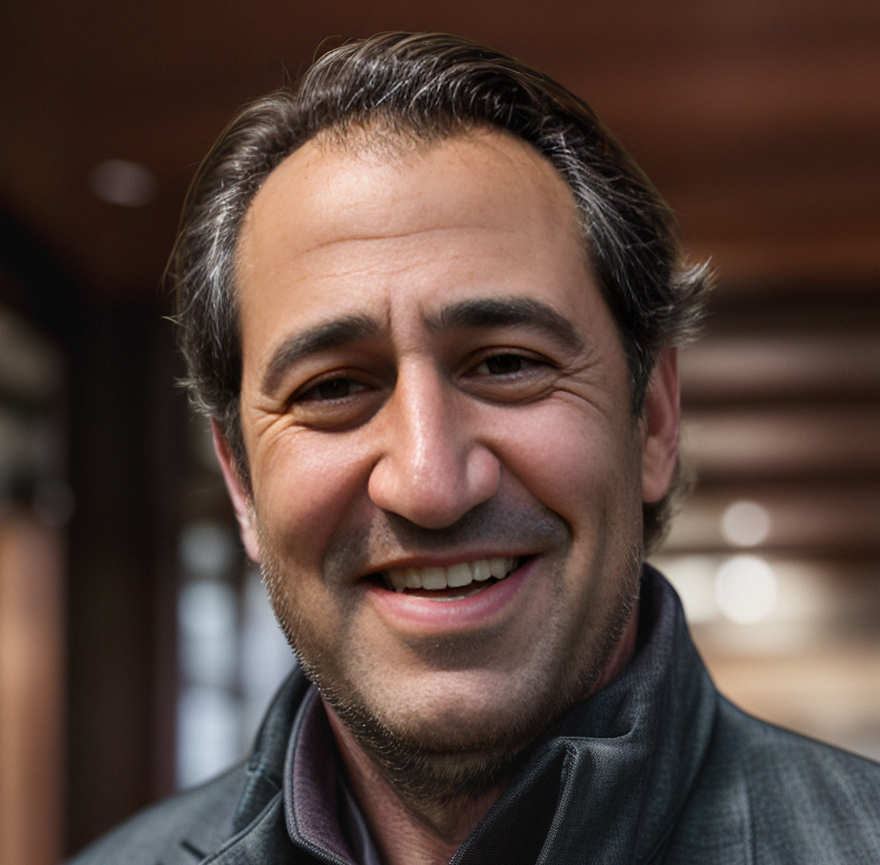
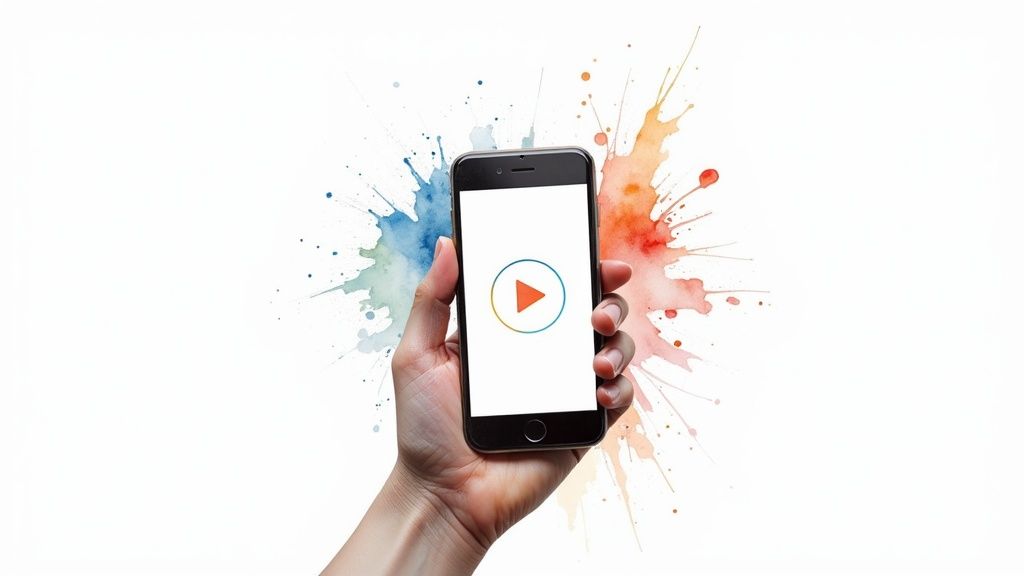
.jpg)